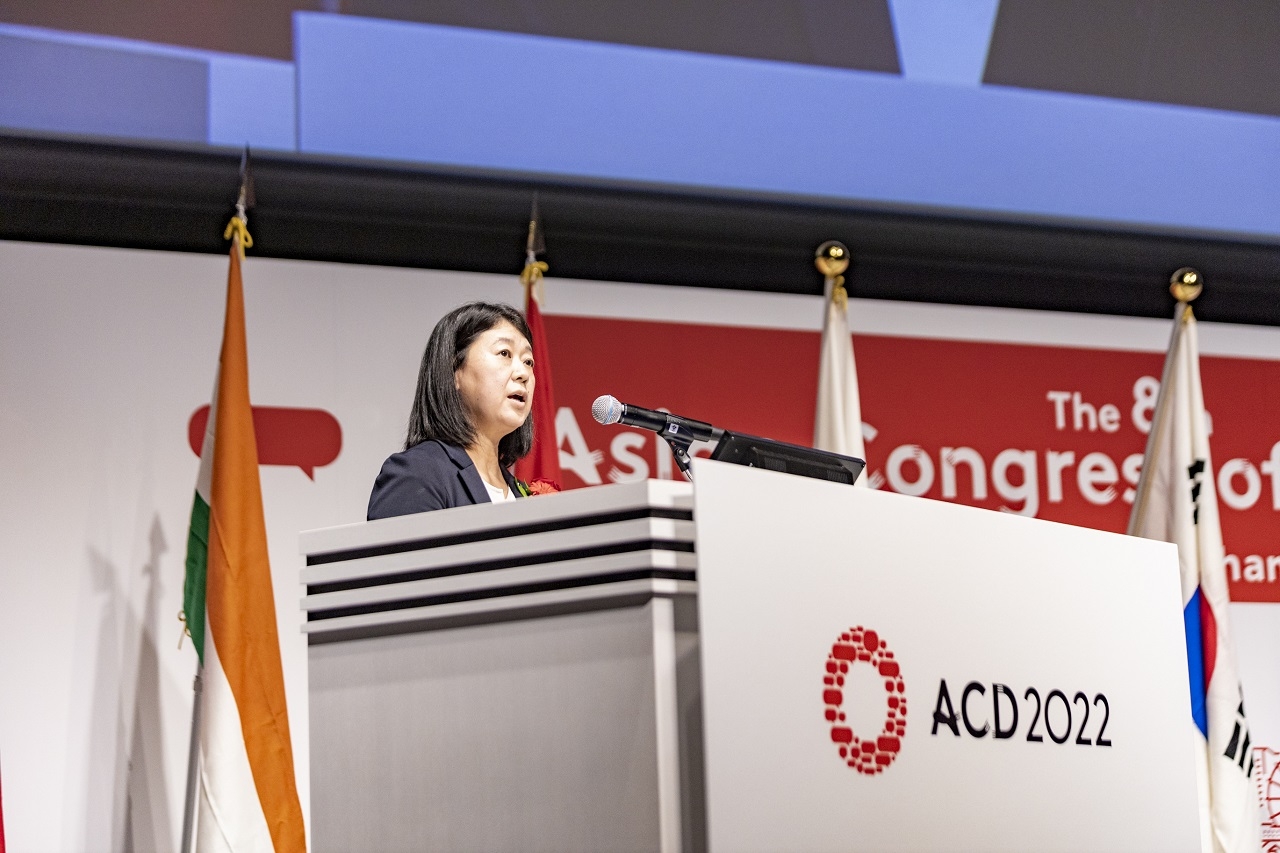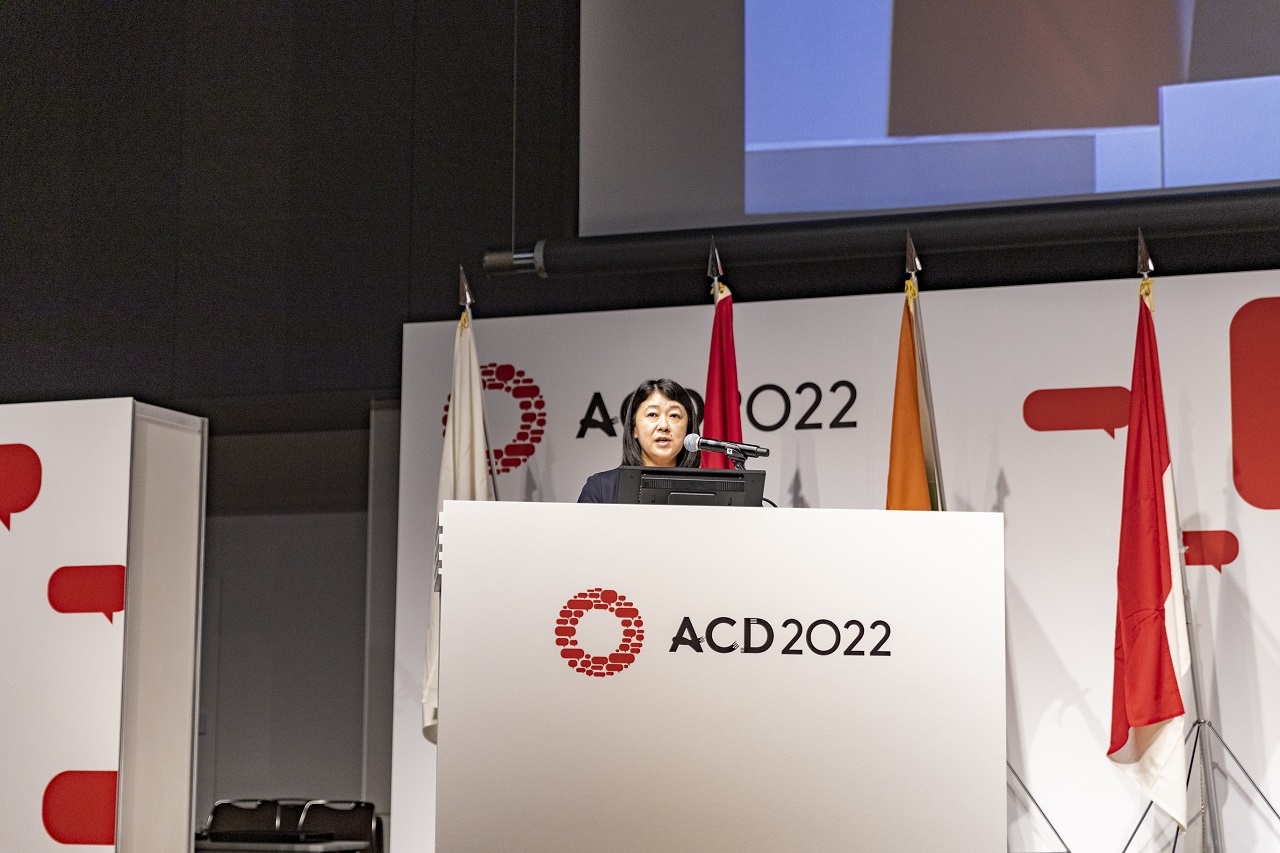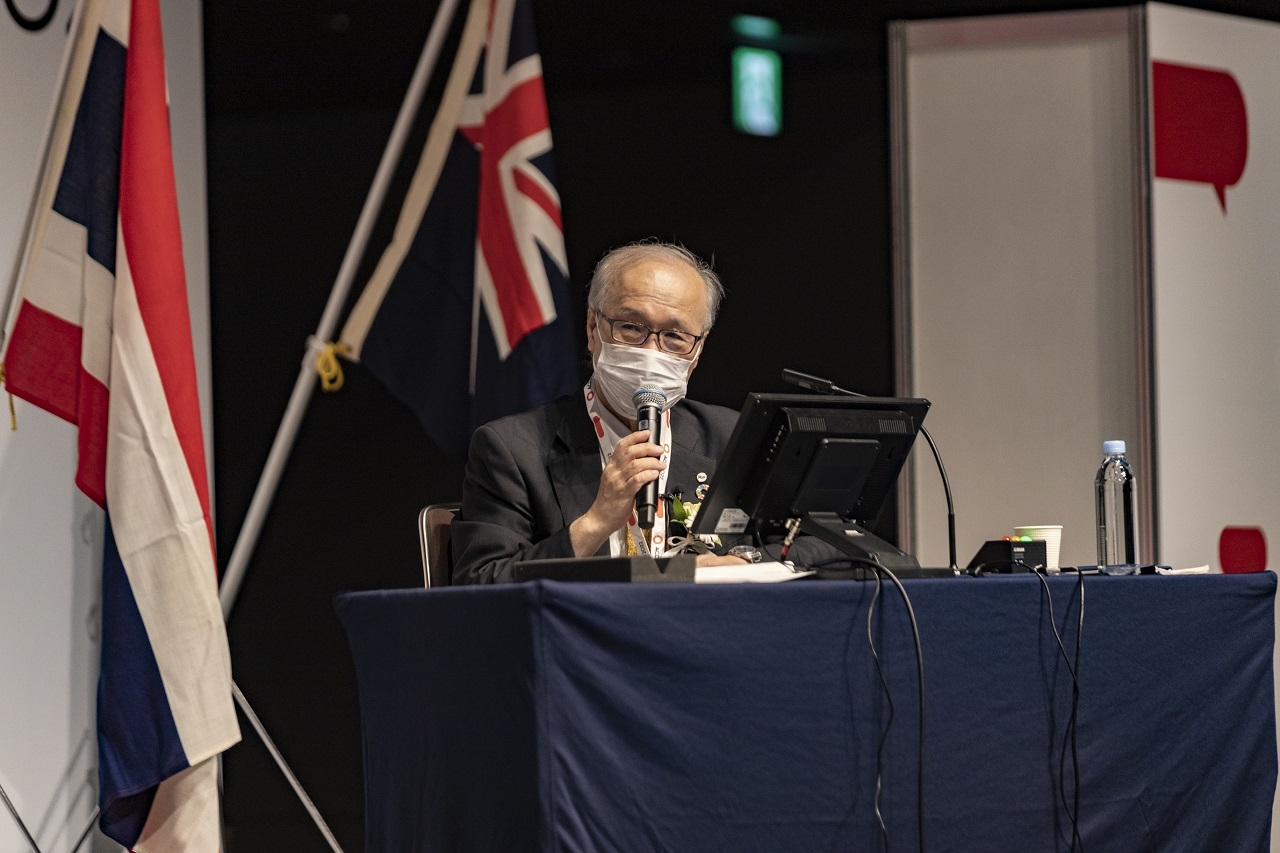【ACD2022 lecture report 1】
Asian countries focus on 'Japan's nutrition policy that leaves no one behind'

Tokue Seino, Director, Nutrition Guidance Office, Health Division, Health Bureau, Ministry of Health, Labour and Welfare, Japan, gave a lecture on the first day of The 8th Asian Congress of dietetics; ACD2022, entitled 'Nutrition Policy in Japan to Leave Registered Dietitians/Dietitians (Nutrition Policy in Japan that leaves no one behind and the role of dietitians and nutritionists)'.
Honorary President Chwang Leh-Chii of the Asian Federation of Dietetic Associations (AFDA), who chaired the lecture "Japan Nutrition" just prior to the meeting, praised Japan's nutrition policy, saying, "If Japan's experience and knowledge can lead the way in making this a joint Asian initiative, I think Asia as a whole can contribute to a better world. “As such, Asian countries are beginning to train nutritionists as nutrition professionals (and train larger numbers in countries where nutritionists already exist) and are moving to deploy them within their countries. Nutrition policy has been one of the country's policies for almost 100 years, and has attracted the attention of dietitians from all countries, who have tried to learn from Japan's journey from a time of food shortages after World War II to a country with a long-life expectancy.
In her lecture, Ms. Seino began by noting that the Ministry of Health, Labor and Welfare, which leads nutrition policy in Japan, has been “responding to changing nutrition challenges over time". Then divided the approximately 100 years from the establishment of the National Institute of Nutrition in 1920 to the present day into three main eras, detailing the efforts made in each era. The three eras are: the era of addressing nutritional deficiencies, mainly due to food shortages; the era of addressing non-communicable diseases caused by overnutrition due to economic growth; and the era of addressing more complex nutritional challenges due to falling birthrates and an ageing society.
"Japan has faced nutritional deficiencies many times in the past due to food shortages caused by climate change and other factors such as cold weather. For Japan, improved nutrition was essential for the country's development. In order to develop a proper nutrition policy, it was necessary to ensure that it was based on scientific evidence. The Nutrition Research Institute was established in 1920 as a research and study organization. In 1937, before World War II, the Public Health Centers Act, which formed the basis of Primary Health Care (PHC), was enacted and the development of public health centers as centers for the promotion of community health, including maternal and child health and maternal and child nutrition, began. In addition, in 1947, after the war, the Dietitians Act was published, and as a national policy, nutrition professionals began to be trained and deployed throughout the country. This means that even before Japan's economic growth, health centers were staffed by nutrition specialists and a system was in place to initiate and promote nutrition policy."
The double burden of malnutrition that is currently a challenge around the world, particularly in developing countries, is the increasing number of overweight and obese people in urban and affluent areas due to economic development, while the number of undernourished people in rural areas and among the poor has not decreased. This is why there is an urgent need to create systems for improved nutrition in many countries.
As a result of the deployment of health promotion centers and professionals, Ms. Seino assessed that Japan had "largely eliminated nutritional deficiencies by 1950, after the war". However, with economic growth came dietary changes and the need to address non-communicable diseases (NCDs). She informed the audience that the National Health Promotion Measures were initiated in 1978 and continued up to the current "Health Japan 21 (second phase)".
Ms. Seino remarked that as the birthrate continues to decline and the population ages, "more complex nutritional issues will need to be addressed."

Dietitian Systems Respond to Nutritional Challenges of Each Era
Ms. Seino moved on to explain the second topic, "Nutrition Improvement Activities and Placement of Registered Dietitians and Dietitians, in accordance with the law".
In 1924, a private school of nutrition was founded to train nutrition professionals, the predecessors of dietitians, and in 1947, after the war, the Dietitians Law was enacted to institutionalize the training of dietitians under national law. Later, in 1961, universal health coverage was achieved and universal health coverage (UHC) was attained, making health care services available to all citizens everywhere. The following year, in 1962, the Dietitians Law was amended to create the Registered Dietitian System and the training of registered Dietitians began. 40 years later, in 2000, the Dietitians Law was partially amended to clarify the role of Registered Dietitians as personnel who manage the nutrition of injured and sick people, the elderly, and other subjects with complex nutritional issues. The role of dietitians was clarified.
Explaining the above trend along with nutritional issues of each era, Ms. Seino showed the steadily increasing number of nutrition professionals, with a cumulative total of 230,000 licensed registered dietitians and 1,070,000 licensed dietitians promulgated, and introduced that in Japan, registered dietitians and dieticians work in various domestic locations including local governments, childcare facilities, schools, hospitals, senior citizen facilities, Self Defense Forces, prisons, private companies and research institutions.
Creating a healthy and sustainable food environment is the next challenge
As the third theme of her speech, Ms. Seino proceeded with "Strengthening Nutrition Policies in line with the SDGs".
The SDGs, a set of common goals for a sustainable and better world, consists of 17 goals and 169 targets, all of which pledge to "leave no one behind". This key phrase is the title of this year's presentation, "Nutrition Policy in Japan to Leave No One Behind," and Ms. Seino mentioned that "I think Japan is unique in that it has implemented a nutrition policy that leaves no one behind," and listed three characteristics of Japan's nutrition policy.
One is that regular health and medical checkups are conducted throughout the country at all life stages, so that each citizen can monitor his or her own health and nutritional status. Moreover, a system should be in place to provide individualized nutritional support when needed. Also, efforts should be made to emphasize measures against frailty and prevention of low nutrition even in the elderly stage.
Second, it also covers nutritional care for the injured and sick, and public medical insurance provides access to detailed nutritional care not only during hospitalization, but also in outpatient settings and at home. Thus, Japan has achieved "integration of nutrition into UHC".
Third, a system is in place to provide nutrition and dietary support to disaster victims even in the event of a major disaster. This is not only to provide nutritional and dietary support activities in the event of a disaster, but also to set guidelines for nutrient intake and other aspects of nutritional management for disaster victims in evacuation centers even in normal times. The system also allows local governments to simulate the amount of food stockpiles that should be available for the population and people in need in each area.
After explaining the above, Ms. Seino concluded, "Japanese Registered Dietitians and Dietitians have taken an important role in advancing PHC and UHC. And Japan's nutrition policy covers all life stages in line with the SDGs".
Additionally, she summarized and conveyed the Japanese government's commitment at the Tokyo Nutrition Summit 2021 held last December, and indicated the direction of the future: "To further promote a nutrition policy that leaves no one behind, we will develop a major nutrition policy package that includes the promotion of a healthy and sustainable food environment through collaboration among industry, government, and academia by addressing issues such as excessive salt intake, emaciation among young women, and nutrition disparities associated with economic conditions".
She concluded by expressing her aspirations, "I would like to contribute to the realization of a sustainable society by drawing on Japan's more than 100 years of experience in nutrition policy".

Chairperson Teiji Nakamura asked, "What do you think Japanese registered dietitians and Dietitians can do to improve nutrition in Asia?" Ms. Seino responded, "Japan's nutrition policy has been centered on maternal and child nutrition and primary health care. This foundation is considered to be Japan's strength, and I hope that Japanese registered Dietitians and Dietitians will spread their respective knowledge at international conferences such as this ACD and to dietitians in other countries".
She added, "Not only in Japan, Asian countries have a nutritional challenge of excessive salt intake, which is not seen in Europe or the United States. In March of this year, the Ministry of Health, Labor and Welfare launched the 'Healthy and Sustainable Food Environment Strategy Initiative' in collaboration with industry, government, and academia, and has just begun activities centered on nutritional perspectives such as the promotion of salt reduction. Let's create a Japanese model for creating a food environment where no one is left behind and propose it to Asia and the world," she concluded her lecture by calling on the registered dietitians and dieticians in the audience to join the initiative.

